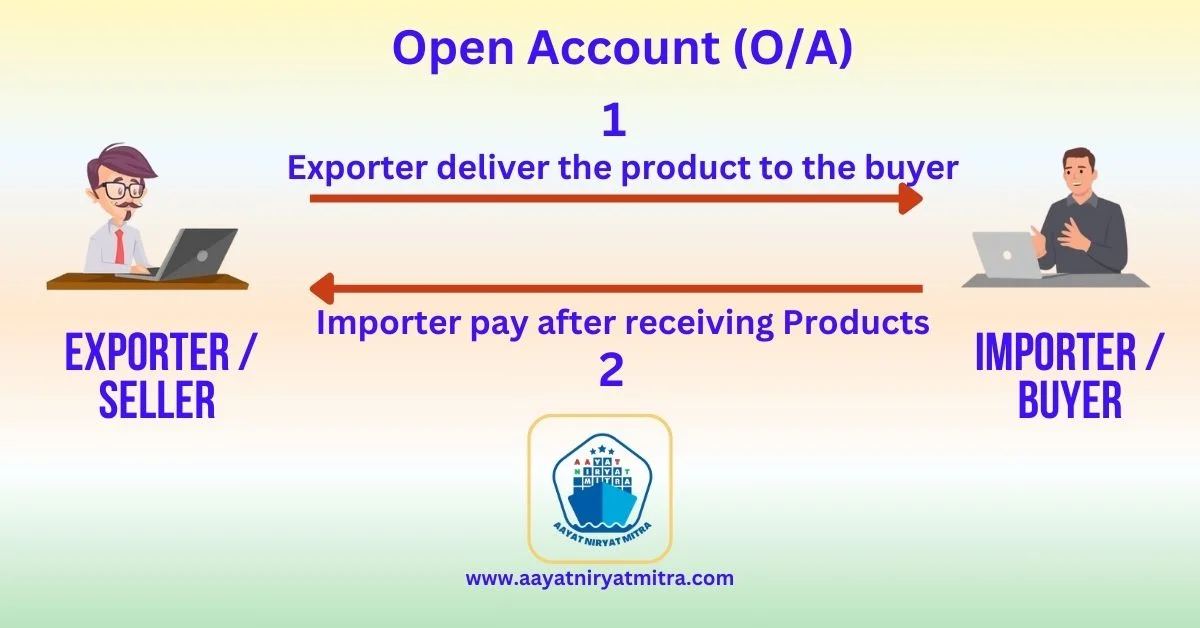Explore the world of international trade finance and learn the basics of Open Account (O/A), a popular mechanism for settling cross-border transactions. This comprehensive reference will enlighten you on the O/A process, from its beginnings to its practical uses, allowing you to make educated decisions and streamline your international trade processes.
Introduction:
Open Account (O/A) is a cornerstone of trade finance in the dynamic world of international commerce, allowing the flow of products and services between partners across borders. The exporter releases items to the importer without requesting previous payment, depending on the importer’s creditworthiness to pay within an agreed-upon credit period.
Also Read | Payment Terms for Exports
Also Read | (TT) Telegraphic Transfer
Also Read | (L/C) Letter of Credit
What is an Open Account (O/A)?
Open Account (O/A) is a trade financing method in which the exporter sends items to the importer based on trust and an agreed-upon payment term, usually within a predetermined credit period. The exporter essentially lends credit to the importer, anticipating payment upon delivery or within the term agreed upon.
How does an Open Account (O/A) work?
The O/A process typically involves the following steps:
Contract of Sale
The exporter and importer sign a sales contract defining the details of the transaction, including the items to be sent, the agreed-upon price, and payment conditions (Open Account).
- Exporter/Seller: This is the entity initiating the exchange, responsible for offering and transferring ownership of goods or services. Sometimes termed the vendor, the seller sets the foundation for the impending transaction.
- Importer/Buyer: On the other side of the coin, we have the buyer—the party agreeing with the intent to buy and take ownership of the specified goods or services. Also dubbed the purchaser, the buyer stands as a crucial counterpart to the deal.
This legal agreement meticulously delineates the terms and conditions governing the transaction, covering pivotal aspects such as:
- Subject of the sale: This specifies what’s changing hands—be it a tangible product, a service, or intellectual property.
- Price: The agreed-upon cost of the goods or services, encompassing currency and payment terms.
- Delivery: Clarification on how and when the goods or services will reach the buyer.
- Ownership transfer: The moment when ownership officially shifts from the seller to the buyer.
- Payment terms: Details on how the buyer will settle the payment, encompassing timing and accepted methods.
- Warranties and guarantees: Any commitments made by the seller regarding the quality, functionality, or performance of the goods or services.
- Return policy: Guidelines on whether the buyer can return the goods or services and the conditions under which this is possible.
- Termination clauses: Legal provisions outlining how either party can conclude the contract.
In essence, a contract of sale establishes a binding agreement that holds both the seller and buyer accountable, ensuring they fulfill their respective obligations while safeguarding their rights throughout the transaction.
Some key considerations to bear in mind:
- Contracts of sale can take various forms—oral, written, or a combination of both. However, opting for written contracts is generally advisable for larger or more intricate transactions to prevent misunderstandings.
- Both parties are bound to act in good faith, requiring them to engage honestly and fairly in line with the contract’s terms.
- If one party breaches the contract, the other may seek legal recourse, such as pursuing damages or attempting to annul the agreement.
Shipment and Documentation:
The exporter sends the items to the importer and creates all shipping documentation, including a commercial invoice, packing list, and bill of lading.
Goods Receipt:
The items are received by the importer, who inspects them for quality and condition.
Payment:
The importer makes the agreed-upon payment to the exporter’s account within the specified credit period.
Advantages of Open Account (O/A)
O/A offers several advantages for both exporters and importers:
For Exporters:
- Simplified Payment Process: Reduces administrative burdens and streamlines the payment process.
- Enhanced Customer Relationships: Fosters trust and strengthens business relationships.
- Improved Market Access: Expand market reach by facilitating transactions with new customers.
For Importers:
- Deferred Payment: Allows for deferred payment, improving cash flow management.
- Reduced Upfront Costs: Eliminates the need for pre-shipment payments.
- Enhanced Negotiating Power: Provides leverage to negotiate favorable payment terms.
Disadvantages of Open Account (O/A)
O/A also carries some drawbacks:
For Exporters:
- Increased Payment Risk: Exposes the exporter to the risk of non-payment.
- Limited Credit Protection: Offers minimal protection against non-payment compared to other trade finance methods.
- Potential for Disputes: This may lead to disputes regarding the quality or condition of the goods.
For Importers:
- Strict Credit Requirements: May face stricter creditworthiness assessments.
- Reputational Risks: Non-payment can damage their reputation and hinder future transactions.
- Potential for Delays: Payment delays can disrupt supply chains and business operations.
Also Read | (D/A) Documents against Acceptance
Also Read | (D/P) Documents against Payment
FAQs on Open Account (O/A)
-
Q: What is an Open Account (O/A) in international trade?
Ans: An Open Account is a payment arrangement where goods are shipped and delivered before payment is due. The seller trusts the buyer to make the payment within an agreed-upon timeframe.
-
Q: How does an Open Account transaction work?
Ans: In an Open Account transaction, the seller ships the goods and sends the invoice to the buyer. The buyer is expected to make the payment based on the agreed-upon credit terms.
-
Q: What are the advantages of using Open Account terms?
Ans: Open Account terms are advantageous for buyers as they receive the goods before making the payment. Sellers benefit from increased competitiveness and potentially stronger relationships with buyers.
-
Q: What are the risks associated with Open Account transactions?
Ans: The primary risk is that the buyer may not make the payment on time or at all. This can pose a financial risk to the seller. Managing credit risk is crucial in Open Account transactions.
-
Q: How are credit terms negotiated in Open Account transactions?
Ans: Credit terms, such as the payment period, are negotiated between the buyer and the seller. Common terms include Net 30, Net 60, or other agreed-upon periods for payment.
-
Q: Can Open Account transactions be used for international trade?
Ans: Yes, Open Account terms are commonly used in international trade, especially when there is a well-established and trusted relationship between the buyer and the seller.
-
Q: Is there a need for a letter of credit in an Open Account transaction?
Ans: No, an Open Account transaction does not involve a letter of credit. Instead, it relies on the trust between the parties, and the buyer’s commitment to making the payment.
-
Q: What documents are typically involved in Open Account transactions?
Ans: In Open Account transactions, standard shipping and commercial documents are involved, such as invoices, bills of lading, and packing lists.
-
Q: How does the seller mitigate the risk in Open Account transactions?
Ans: The seller can mitigate risk by conducting credit checks on the buyer, setting appropriate credit limits, and possibly obtaining credit insurance.
-
Q: Can Open Account terms be combined with other payment methods?
Ans: Yes, it’s possible to combine Open Account terms with other methods, such as credit insurance or factoring, to further mitigate risk and provide financial flexibility.
-
Q: What is the role of banks in Open Account transactions?
Ans: Unlike letters of credit, banks do not play a direct role in Open Account transactions. The financial transaction occurs directly between the buyer and the seller.
-
Q: Are Open Account transactions suitable for all types of products?
Ans: Open Account transactions are more common for products with a history of successful transactions between the parties and when there is a high level of trust.
-
Q: What are the different types of Open Account (O/A) terms?
Ans: There are two main types of O/A terms:
1. O/A at Sight: Payment is due upon receipt of the goods.
2. O/A at Usance: Payment is due at a predetermined date after receipt of the goods. -
Q: What are the key considerations for using Open Account (O/A) terms?
Ans: *Carefully evaluate the creditworthiness of the importer.
*Establish clear payment terms and a credit period.
*Implement risk mitigation strategies, such as credit insurance or factoring.
*Monitor payments closely and take prompt action in case of delays.
Conclusion:
Open Account (O/A) serves as a widely used and versatile trade finance mechanism, facilitating international transactions by balancing the risk and control between the exporter and the importer. For exporters, O/A offers simplified payment processes, enhanced customer relationships, and improved market access. For importers, O/A provides deferred payment, reduced upfront costs, and enhanced negotiating power. While O/A carries some risks, such as increased payment risk and limited credit protection, it remains a popular choice for international trade due to its simplicity and cost-effectiveness.
If you discover an error in the “Open Account (O/A): A Comprehensive Guide 2024” information provided to us, please notify us immediately via the comment box and email; if the information provided by you is correct, We will change it.
If you enjoyed this article, please share it with your friends. Please visit Aayat Niryat Mitra | Import Export Friend for more information on this and other topics. Thank you for stopping by.

